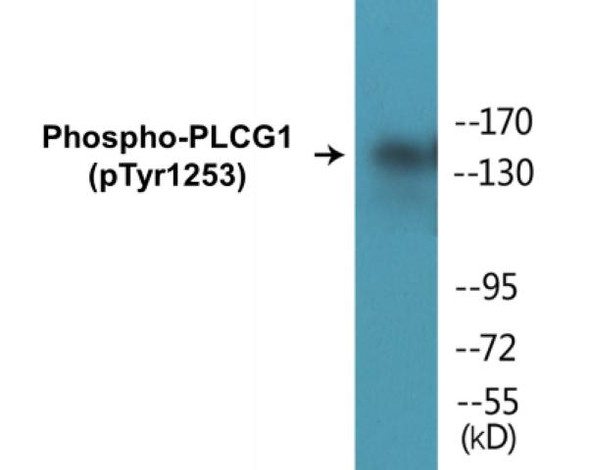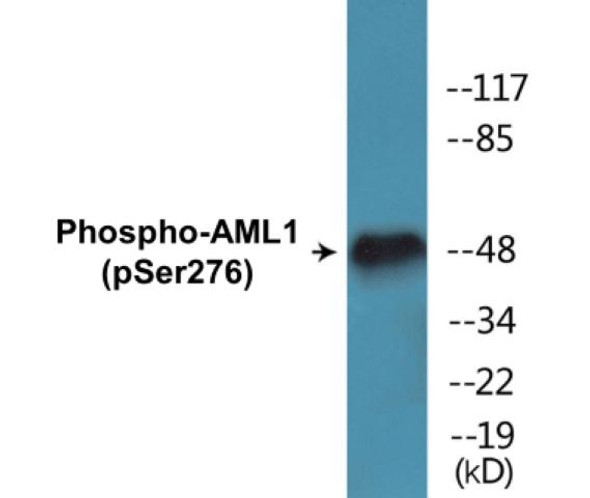Description
WAVE1 (Phospho-Tyr125)Colorimetric Cell-Based ELISA Kit
The Wave1 Phospho-Tyr125 Colorimetric Cell-Based ELISA Kit is a cutting-edge tool for accurately measuring the levels of phosphorylated Wave1 protein at the Tyr125 site in cell samples. This kit offers exceptional sensitivity and specificity, providing reliable and consistent results for a variety of research applications.Wave1 protein is a key regulator of actin dynamics and cell migration, making it a critical player in processes like cell adhesion, proliferation, and invasion. Phosphorylation of Wave1 at the Tyr125 site has been implicated in various cellular signaling pathways and diseases, highlighting its importance as a potential therapeutic target.
Whether you are studying cancer metastasis, neuronal development, or cellular signaling pathways, the Wave1 Phospho-Tyr125 Colorimetric Cell-Based ELISA Kit is an invaluable tool for uncovering novel insights into these complex biological processes. Order your kit today and take your research to the next level.
| Product Name: | WAVE1 (Phospho-Tyr125)Colorimetric Cell-Based ELISA Kit |
| Product Code: | CBCAB01330 |
| ELISA Type: | Cell-Based |
| Target: | WAVE1 (Phospho-Tyr125) |
| Reactivity: | Human, Mouse, Rat |
| Dynamic Range: | > 5000 Cells |
| Detection Method: | Colorimetric 450 nm |
| Format: | 2 x 96-Well Microplates |
The WAVE1 (Phospho-Tyr125) Colorimetric Cell-Based ELISA Kit is a convenient, lysate-free, high throughput and sensitive assay kit that can detect WAVE1 protein phosphorylation and expression profile in cells. The kit can be used for measuring the relative amounts of phosphorylated WAVE1 in cultured cells as well as screening for the effects that various treatments, inhibitors (ie. siRNA or chemicals), or activators have on WAVE1 phosphorylation.
Qualitative determination of WAVE1 (Phospho-Tyr125) concentration is achieved by an indirect ELISA format. In essence, WAVE1 (Phospho-Tyr125) is captured by WAVE1 (Phospho-Tyr125)-specific primary (1ø) antibodies while the HRP-conjugated secondary (2ø) antibodies bind the Fc region of the 1ø antibody. Through this binding, the HRP enzyme conjugated to the 2ø antibody can catalyze a colorimetric reaction upon substrate addition. Due to the qualitative nature of the Cell-Based ELISA, multiple normalization methods are needed:
| 1. | A monoclonal antibody specific for human GAPDH is included to serve as an internal positive control in normalizing the target absorbance values. |
| 2. | Following the colorimetric measurement of HRP activity via substrate addition, the Crystal Violet whole-cell staining method may be used to determine cell density. After staining, the results can be analysed by normalizing the absorbance values to cell amounts, by which the plating difference can be adjusted. |
| Database Information: | Gene ID: 8936, UniProt ID: Q92558, OMIM: 605035, Unigene: Hs.75850 |
| Gene Symbol: | WASF1 |
| Sub Type: | Phospho |
| UniProt Protein Function: | WAVE1: Downstream effector molecule involved in the transmission of signals from tyrosine kinase receptors and small GTPases to the actin cytoskeleton. Promotes formation of actin filaments. Part of the WAVE complex that regulates lamellipodia formation. The WAVE complex regulates actin filament reorganization via its interaction with the Arp2/3 complex. Belongs to the SCAR/WAVE family. |
| UniProt Protein Details: | Protein type:Motility/polarity/chemotaxis; Cytoskeletal Chromosomal Location of Human Ortholog: 6q21 Cellular Component: actin cytoskeleton; cytoskeleton; focal adhesion; lamellipodium; mitochondrial outer membrane; synapse Molecular Function:actin binding; protein binding; protein complex binding; Rac GTPase binding Biological Process: actin filament polymerization; cell motility; protein complex assembly; Rac protein signal transduction |
| NCBI Summary: | The protein encoded by this gene, a member of the Wiskott-Aldrich syndrome protein (WASP)-family, plays a critical role downstream of Rac, a Rho-family small GTPase, in regulating the actin cytoskeleton required for membrane ruffling. It has been shown to associate with an actin nucleation core Arp2/3 complex while enhancing actin polymerization in vitro. Wiskott-Aldrich syndrome is a disease of the immune system, likely due to defects in regulation of actin cytoskeleton. Multiple alternatively spliced transcript variants encoding the same protein have been found for this gene. [provided by RefSeq, Jul 2008] |
| UniProt Code: | Q92558 |
| NCBI GenInfo Identifier: | 2495730 |
| NCBI Gene ID: | 8936 |
| NCBI Accession: | Q92558.1 |
| UniProt Secondary Accession: | Q92558,Q5SZK7, E1P5F2, |
| UniProt Related Accession: | Q92558 |
| Molecular Weight: | 61,652 Da |
| NCBI Full Name: | Wiskott-Aldrich syndrome protein family member 1 |
| NCBI Synonym Full Names: | WAS protein family member 1 |
| NCBI Official Symbol: | WASF1 |
| NCBI Official Synonym Symbols: | WAVE; SCAR1; WAVE1 |
| NCBI Protein Information: | wiskott-Aldrich syndrome protein family member 1 |
| UniProt Protein Name: | Wiskott-Aldrich syndrome protein family member 1 |
| UniProt Synonym Protein Names: | Protein WAVE-1; Verprolin homology domain-containing protein 1 |
| Protein Family: | Wiskott-Aldrich syndrome protein family |
| UniProt Gene Name: | WASF1 |
| UniProt Entry Name: | WASF1_HUMAN |
| Component | Quantity |
| 96-Well Cell Culture Clear-Bottom Microplate | 2 plates |
| 10X TBS | 24 mL |
| Quenching Buffer | 24 mL |
| Blocking Buffer | 50 mL |
| 15X Wash Buffer | 50 mL |
| Primary Antibody Diluent | 12 mL |
| 100x Anti-Phospho Target Antibody | 60 µL |
| 100x Anti-Target Antibody | 60 µL |
| Anti-GAPDH Antibody | 60 µL |
| HRP-Conjugated Anti-Rabbit IgG Antibody | 12 mL |
| HRP-Conjugated Anti-Mouse IgG Antibody | 12 mL |
| SDS Solution | 12 mL |
| Stop Solution | 24 mL |
| Ready-to-Use Substrate | 12 mL |
| Crystal Violet Solution | 12 mL |
| Adhesive Plate Seals | 2 seals |
The following materials and/or equipment are NOT provided in this kit but are necessary to successfully conduct the experiment:
- Microplate reader able to measure absorbance at 450 nm and/or 595 nm for Crystal Violet Cell Staining (Optional)
- Micropipettes with capability of measuring volumes ranging from 1 µL to 1 ml
- 37% formaldehyde (Sigma Cat# F-8775) or formaldehyde from other sources
- Squirt bottle, manifold dispenser, multichannel pipette reservoir or automated microplate washer
- Graph paper or computer software capable of generating or displaying logarithmic functions
- Absorbent papers or vacuum aspirator
- Test tubes or microfuge tubes capable of storing ≥1 ml
- Poly-L-Lysine (Sigma Cat# P4832 for suspension cells)
- Orbital shaker (optional)
- Deionized or sterile water
*Note: Protocols are specific to each batch/lot. For the correct instructions please follow the protocol included in your kit.
| Step | Procedure |
| 1. | Seed 200 µL of 20,000 adherent cells in culture medium in each well of a 96-well plate. The plates included in the kit are sterile and treated for cell culture. For suspension cells and loosely attached cells, coat the plates with 100 µL of 10 µg/ml Poly-L-Lysine (not included) to each well of a 96-well plate for 30 minutes at 37 °C prior to adding cells. |
| 2. | Incubate the cells for overnight at 37 °C, 5% CO2. |
| 3. | Treat the cells as desired. |
| 4. | Remove the cell culture medium and rinse with 200 µL of 1x TBS, twice. |
| 5. | Fix the cells by incubating with 100 µL of Fixing Solution for 20 minutes at room temperature. The 4% formaldehyde is used for adherent cells and 8% formaldehyde is used for suspension cells and loosely attached cells. |
| 6. | Remove the Fixing Solution and wash the plate 3 times with 200 µL 1x Wash Buffer for five minutes each time with gentle shaking on the orbital shaker. The plate can be stored at 4 °C for a week. |
| 7. | Add 100 µL of Quenching Buffer and incubate for 20 minutes at room temperature. |
| 8. | Wash the plate 3 times with 1x Wash Buffer for 5 minutes each time. |
| 9. | Add 200 µL of Blocking Buffer and incubate for 1 hour at room temperature. |
| 10. | Wash 3 times with 200 µL of 1x Wash Buffer for 5 minutes each time. |
| 11. | Add 50 µL of 1x primary antibodies Anti-WAVE1 (Phospho-Tyr125) Antibody, Anti-WAVE1 Antibody and/or Anti-GAPDH Antibody) to the corresponding wells, cover with Parafilm and incubate for 16 hours (overnight) at 4 °C. If the target expression is known to be high, incubate for 2 hours at room temperature. |
| 12. | Wash 3 times with 200 µL of 1x Wash Buffer for 5 minutes each time. |
| 13. | Add 50 µL of 1x secondary antibodies (HRP-Conjugated AntiRabbit IgG Antibody or HRP-Conjugated Anti-Mouse IgG Antibody) to corresponding wells and incubate for 1.5 hours at room temperature. |
| 14. | Wash 3 times with 200 µL of 1x Wash Buffer for 5 minutes each time. |
| 15. | Add 50 µL of Ready-to-Use Substrate to each well and incubate for 30 minutes at room temperature in the dark. |
| 16. | Add 50 µL of Stop Solution to each well and read OD at 450 nm immediately using the microplate reader. |
(Additional Crystal Violet staining may be performed if desired – details of this may be found in the kit technical manual.)






